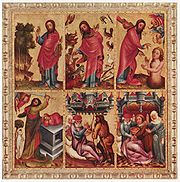
Master Bertram
Encyclopedia

International Gothic
International Gothic is a phase of Gothic art which developed in Burgundy, Bohemia, France and northern Italy in the late 14th century and early 15th century...
painter primarily of religious art. His most famous surviving work is the large Grabow Altarpiece (or Petri-Altar) in the Kunsthalle Hamburg
Kunsthalle Hamburg
The Hamburger Kunsthalle is an art museum in Hamburg, Germany. The art museum focuses on painting in Hamburg in the 14th century, paintings by Dutch and Flemish artists of the 16th and 17th centuries, French and German paintings of the 19th century, modern, and contemporary art...
, the largest and most important North German painting of the period. There is a 45-scene altarpiece of the Apocalypse
Apocalypse
An Apocalypse is a disclosure of something hidden from the majority of mankind in an era dominated by falsehood and misconception, i.e. the veil to be lifted. The Apocalypse of John is the Book of Revelation, the last book of the New Testament...
, probably by his workshop, in the Victoria and Albert Museum
Victoria and Albert Museum
The Victoria and Albert Museum , set in the Brompton district of The Royal Borough of Kensington and Chelsea, London, England, is the world's largest museum of decorative arts and design, housing a permanent collection of over 4.5 million objects...
in London. He, or his workshop, also produced sculpture, presumably in wood; in fact in his first years in Hamburg most surviving documentation relates to sculpture, including chandelier
Chandelier
A chandelier is a branched decorative ceiling-mounted light fixture with two or more arms bearing lights. Chandeliers are often ornate, containing dozens of lamps and complex arrays of glass or crystal prisms to illuminate a room with refracted light...
s.
He is first recorded in Hamburg in 1367, and lived there for the rest of his life, becoming a citizen and Master in 1376, and achieving considerable prosperity. In 1390 he made a will in advance of an intended pilgrimage to Rome, but if he made the journey it had no detectable influence on his art. He was married, but his wife had died by his second will in 1410, when he had a surviving daughter. His style is less emotional than that of his Hamburg near-contemporary Master Francke, but has great charm.
Bertram was largely forgotten after the Renaissance until the end of the 19th century when, like Master Francke, he was rediscovered and published by Alfred Lichtwark, Director of the Hamburg Kunsthalle.[1]
Literature
- Dube, Elizabeth Healy: "The Grabow Altar of Master Bertram von Minden", Providence, Brown Univ., Diss., 1982

